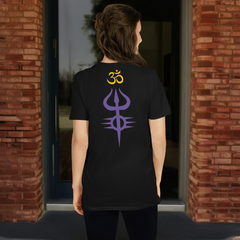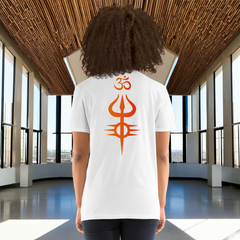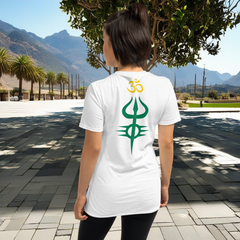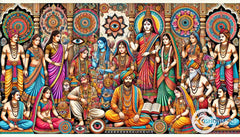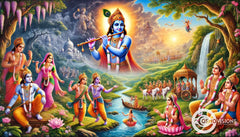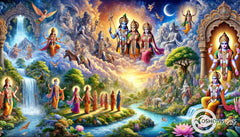Power of Shakti Shiva: Divine Union of Masculine and Feminine Energy

In today's fast-paced world, many of us feel disconnected from our inner selves and the universe around us. This sense of detachment can lead to a search for something more profound, a deeper connection that resonates with both our physical and spiritual existence.
The ancient wisdom of Hinduism speaks of the relationship between Shiva and Shakti, two fundamental forces that represent the divine union of masculine form and feminine energy within the cosmos. This concept illustrates the balance necessary for harmony in nature and offers insights into how we can achieve a similar equilibrium within ourselves.
One fascinating aspect is that this union plays a critical role in consciousness and energy flow throughout the entire universe itself; it's central to practices like yoga, Tantra, and meditation aimed at awakening one's Kundalini.
By exploring Shiva Shakti practices—encompassing mantra chanting, lotus yoga, pranayama breathing techniques—we uncover pathways to elevate our minds and spirits towards greater awareness and self-realization.
Our article serves as your guide to understanding these energies' impact on many aspects of your life and how embracing them can open doors to transcending ordinary states of human being towards true enlightenment.
Discover harmony within you.
What is the concept of shiva and shakti?
Shiva and Shakti represent the cosmic duality of masculine and feminine principles, essential for creation, sustenance, and destruction in Hindu philosophy. While the god Shiva embodies pure consciousness and stillness, his counterpart Shakti signifies energy and vitality.
Together, they form a dynamic balance that underlies all aspects of life. This union exemplifies how contrasting forces can coexist harmoniously to foster growth and transformation.
Exploring this concept further reveals deep insights into yoga practice and spiritual awakening. The balance between these two energies facilitates an understanding of mind-body dualism, guiding practitioners to unity with the divine.
Such wisdom enriches one's spiritual journey and offers practical applications in chakra alignment and meditation techniques.
Om Namah Shivaya - a mantra that encapsulates the essence of Shiva-Shakti's divine harmony.
As we explore their roles within Hinduism, it becomes clear how these deities influence our perception of divinity and self-realization.

Understanding the meaning of shiva and shakti
Shiva and Shakti stand as the paramount symbols of duality yet unity, embodying the divine masculine and feminine energies that pervade every aspect of life. These concepts do more than just represent physical or gender differences; they are fundamental forces within the universe, essential for creation, preservation, and destruction.
Shiva reflects absolute consciousness - the formless space in which all potential exists. In contrast, Shakti embodies energy - the dynamic force that brings this potential into reality.
This divine union signifies balance and harmony between opposing forces, illustrating how different aspects can complement each other to create wholeness. Through their dance of cosmic love and power, they maintain the cycle of life, underscoring a profound teaching in Hinduism: that understanding our inner Shiva and Shakti is crucial for spiritual awakening.
Engaging with these aspects through practices such as yoga helps align one's body and spirit with this universal balance, unfolding creative potential both internally and externally while fostering unconditional love.
How shiva and shakti represent duality and unity
Having explored the meaning of Shiva and Shakti, we now delve into how these divine forces embody both duality and unity. Shiva represents consciousness, the unchanging, infinite aspect of the universe, while Shakti embodies energy, power, and change.
Together, they form a complete whole, illustrating that everything in existence is a blend of static space (Shiva) and dynamic energy (Shakti). This concept mirrors the fundamental truths about life itself: stability coexists with transformation; creation arises from the balance between preservation and destruction.
In this union lies the universal principle that opposites are essential for harmony. Just as day turns to night and strength pairs with gentleness, Shiva's stillness perfectly complements Shakti's movement.
Their dance creates life as we know it—manifesting not just in grand cosmic cycles but also within our own experiences. By recognizing ourselves as amalgamations of both masculine and feminine energies—sun and moon, consciousness and action—we unlock deeper understandings of our nature and potential.
This symbolic representation teaches us that embracing duality leads to unity; by balancing internal Shiv-Shakti energies through practices like yoga or meditation we achieve wholeness within ourselves.
The role of shiva and shakti in Hinduism
In Hinduism, Shiva Shakti represents the quintessential male and female forces that animate the world. Shiva embodies consciousness and formlessness, while Shakti symbolizes energy, creativity, and materiality.
Their union is not just a mythical story but a central concept in Shaivism and Shaktism, illustrating how the universe operates through a dynamic balance of masculine and feminine principles.
This divine couple’s role extends to spiritual practices where devotees seek to harmonize these divine energies from within themselves through yoga, meditation, and devotion.
Shiva is often depicted in Hindu texts engaging in the Tandava dance, which symbolizes cosmic cycles of creation and destruction. Meanwhile, manifestations of Shakti such as Parvati, Durga, Sati (Hindu goddess), Lakshmi among others demonstrate the multifaceted nature of this divine feminine power.
Devotees participate in festivals like Maha Shivaratrhi with fervor, honoring Lord Shiva's aspects or invoking his consort's blessings during Navaratri to tap into this profound cosmic and feminine principle within.
Through rituals focusing on these deities' statues or tales celebrated across various temples including notable ones at Shakti Peethas – sites believed to enshrine parts of Goddess Sati's body – adherents connect deeply with both shiv(a) within their own being as well as with universe’s greater rhythm.

How does the union of shiva and shakti affect our energy?
The union of Shiva and Shakti symbolizes the merging of masculine and feminine energies, creating a harmonious balance within our consciousness. This divine amalgamation fosters spiritual awakening, enabling us form a profound connection with the universe's innate vibrancy.
Energies that were once dormant come alive, illuminating paths towards transcendence in religion and spirituality. As practitioners engage in yogic practices that honor both aspects of Shakti and Shiva, they experience enhanced awareness, leading to a deeper appreciation of life's dualities.
Such experiences resonate deeply with those devoted to exploring anthropology, spirituality, and the arts indios.
The dance between the dynamic Shakti and the immovable Shiva creates an energy flow within us that transcends ordinary experiences of self.
This fusion impacts not just individual consciousness but also influences how we interact with external realities. Through practices like alternating nostril breathing (nadi), devotion to deities such as Ganesha and Kali, or engaging in mantra chanting dedicated to these cosmic powers, individuals align their personal energy frequencies with universal rhythms.
Balancing inner Shiva and shakti cultivates equilibrium between action (Shiva) and emotion (Shakti), fostering an environment where creativity flourishes unbounded by societal constraints or personal limitations.
Transitioning from understanding this sacred union's effect on our energy invites us into exploring its practical applications—how we can channel such harmonized forces through yoga practice and chakra alignment for transformative life changes.
Exploring the divine union of masculine and feminine energies
Exploring the divine union of masculine and feminine energies reveals a profound balance within us, mirroring the ancient duality and unity represented by Shiva and Shakti. This spiritual partnership underlines the interconnectedness of all aspects of life, emphasizing how these primal forces interact to foster creation, sustenance, and transformation.
As we engage in practices like yoga or meditative contemplation, we activate an awareness that allows us to experience this sacred harmony firsthand. Through such disciplined endeavors, individuals awaken their inner Devi and Shiva, encouraging a flow of energy that nourishes both mind and body.
Engaging with this dynamic synergy guides practitioners on a journey toward transcendence where masculine deity traits like logic, action, and resolution harmoniously blend with feminine qualities such as intuition, compassion, and creativity.
This equilibrium offers a pathway to holistic well-being by aligning one's Ātman (soul) with the universal Brahman—the ultimate reality. By honoring the divine energy present within through dedicated practice—whether it be mantra chanting or alternate nostril breathing—we unlock deeper layers of consciousness.
This elevates our spiritual health and enhances our physical vitality by facilitating a more intimate connection between the Sahasrara (crown chakra) above us and Mother Earth beneath our feet.
The impact of shiva and shakti on consciousness and energy
The union of Shiva and Shakti transcends mere mythological significance, impacting human history, consciousness and energy in profound ways. Through the embodiment of pure awareness (Shiva) and dynamic power (Shakti), this divine couple illustrates the essential duality present within creation itself.
Practicing yoga cultivates an intimate experience with these forces, guiding practitioners to harmonize their own masculine and feminine energies. This balance fosters a deeper connection to one's Ātman (Hinduism), promoting a state of transcendence beyond the physical dimension.
Key practices such as mantra chanting, kundalini awakening, and chakra alignment serve as building blocks for experiencing the power of Shiva and Shakti. By engaging in these spiritual disciplines, individuals activate latent potentials within, leading to enhanced mind-body dualism understanding and energetic transformation.
Such practices reveal the interconnectedness between individual consciousness and universal energy fields, offering insights into primordial truths that underlie our existence. Moving forward, exploring practical applications in yoga practice opens new avenues for personal growth and spiritual enlightenment.
Practical applications in yoga practice and chakra alignment
Moving from understanding the profound impact of Shiva and Shakti on consciousness and energy, we explore how this divine union enriches our yoga practice and aligns our chakras. Practical applications in these areas offer a pathway to balance femininity and masculinity within, reflecting the harmony of mind-body dualism through ancient practices revered across cultures.
1. Incorporating mantras dedicated to Shiva or Shakti during meditation sessions facilitates deeper spiritual connectivity, awakening the dormant energies within. Reciting "Om Namah Shivaya" connects practitioners to Shiva's transformative power, while invoking Shakti through "Sri Matre Namaha" enhances creative and nurturing forces.
2. Chanting specific sounds or bija mantras for each chakra can stimulate these energy centers, promoting alignment and flow between masculine and feminine energies. For instance, chanting "LAM" for the root chakra (muladhara chakra) helps ground Shiva's stability, while "YAM" opens the heart chakra to Shakti's love.
3. Kundalini yoga practices focus on rising serpent power believed to reside at the base of the spine, unifying mind, body, and spirit in divine harmony akin to Shiva-Shakti's union. Techniques like breath of fire or spinal flexes aim to awaken this latent energy, guiding it through the chakras towards enlightenment.
4. Lotus yoga poses not only symbolize purity and spiritual awakening but also serve as physical embodiments of Shiva-Shakti principles. By adopting positions that open the heart or balance energy distribution, practitioners mirror the cosmic dance of creation and destruction inherent in this duo.
5. Pranayama exercises such as alternate nostril breathing help balance solar (Shiva) and lunar (Shakti) energies within the body. This practice aligns with duality concepts by harmonizing left and right brain functions along with male and female aspects of our being.
6. Engaging in devi-centric rituals allows individuals to connect with goddess aspects of Divinity, enhancing inner femininity – an essential counterpart to masculine consciousness represented by Shiva. These rites often include offerings of flowers or fruits at altars dedicated to mother goddess figures, recitation of Sita's courage in Ramayana tales, or meditation upon warrior goddess forms.
7. Celebrating festivals like Maha Shivaratri or Saundarya Lahari provides opportunities for communal worship of these deities' aspects through song, dance, fasting, and contemplation – practices that embody their narratives' wisdom into daily existence.
8. Discordant elements within personal belief systems may surface during intense periods of practice recognizing internal inconsistencies akin to myths where Sati confronts her father Daksha’s disregard for Lord Shiva. Resolution leads beings closer to holistic wellness, now aligned more closely with universal truths reflected in stories such as Ram Dass teachings hint at embracing all facets including dualities witnessed within Hindu deism mythology.
9. Engaging scriptural studies like reading Bhagavad Gita illuminates Krishna’s discourse on balancing duty (dharma) and pleasure (kama), offering insight into managing personal emotions versus societal expectations mirroring thematic concerns over unity despite apparent separation seen between divine counterparts.
10. Committing oneself fully to understanding philosophies behind actions enables transcendence beyond mere physical postures extending reach into areas where thoughts converge producing clarity; hence regular reflection upon Ishvara provides an anchor amid fluctuating waves influenced by transient desires ensuring adherence to traditions thereby enriching both contemporary existence.
What are the building blocks of shiva shakti practices?
The cornerstone of shiva shakti practices lies in the harmonious blend of mantra, chant, and awakening the kundalini energy. These elements serve as vital conduits for connecting with the divine interplay of masculine and feminine forces.
Mantras and chants work to purify the mind–body dualism, aligning practitioners with higher states of consciousness. Kundalini yoga acts as a powerful tool for transcending ordinary experiences, guiding the potent serpent power from the base of the spine to unite with Shiva within the crown chakra.
Incorporating lotus yoga positions and pranayama (breath control) into one's daily rituals enhances this connection further, opening channels for prana to flow freely and nourish all seven chakras.
Devi-centric rituals focus on invoking Shakti's presence, celebrating her forms and names through specific practices that honor femininity as a divine life force equal to masculinity. Together, these building blocks foster an environment where individuals can experience transcendence (religion), exploring deeper aspects of awareness and unlocking their true spiritual potential.

Key components: mantra, chant, and kundalini
Mantras and chants serve as the vibrational foundation that connects practitioners to the divine energy of Shiva and Shakti. Each mantra, a sacred utterance believed to possess profound spiritual power, acts as a conduit for channeling cosmic energy into the practitioner's consciousness.
Chants, repeated rhythmically, harmonize the individual's vibration with that of the universe, facilitating an intimate connection with Shiva and Shakti. This practice nurtures spiritual awakening and also purifies the mind, preparing it for deeper meditative states.
Kundalini forms an integral part of this process by representing the latent energy situated at the base of the spine. Through specific yogic practices like pranayama (breath control) and lotus yoga—a discipline focusing on aligning physical postures with breath—the kundalini awakens.
This awakening triggers a transformative journey upwards through each chakra or energy center within the body, culminating in samadhi or enlightenment where one achieves unity with Shiva and Shakti's omnipresent consciousness.
Kundalini encapsulates both potentiality and kinetic life force energy that propels individuals toward realizing their divine nature.
The significance of lotus yoga and pranayama
Transitioning from the foundational elements of mantra, chant, and kundalini, we venture into an area where lotus yoga and pranayama emerge as pivotal practices. These techniques offer a direct pathway to harmonize the inner energies of Shiva and Shakti within practitioners.
Lotus yoga positions, known for their grace and stability, symbolize purity rising through adversity; much like the lotus flower that blooms in muddy waters yet remains untouched by its surroundings.
This practice encourages individuals to find balance and beauty amidst life's challenges.
Pranayama, or the control of breath, acts as a vital bridge connecting body and mind to spirit. Through disciplined breathing techniques, one can directly influence their energy levels—raising awareness and promoting an internal shift towards higher consciousness.
Engaging in pranayama allows for a cleansing process to occur within the energy channels (nadis), preparing the practitioner for deeper states of meditation where they can experience union with divine energies.
In every breath taken during pranayama lies an opportunity to ignite our internal fire (Agni), paving way for enlightenment.
Connecting with shiva shakti through devi-centric rituals
Engaging in devi-centric rituals provides a direct pathway to experience the profound energy of Shiva Shakti. These practices, deeply rooted in traditions that honor divinity as both male and female, bring participants closer to understanding the dynamic equilibrium between creation and destruction, symbolized by Shiva and Shakti.
Utilizing mantras, chants linked with gods like Dattatreya, and meditations focused on deities such as Vishnu or Venkateswara can intensify this connection. Devotees often find these activities heighten their awareness of Shakti's omnipresent power.
Participating in ceremonies at Shakti Pithas—sacred sites said to embody Sati's fallen body parts—offers an immersive experience into the core of devotional practice. Here, legends about figures like Kartikeya or Hanuman come alive through ritualistic worship (puja), song (bhajan), and dance (nritya).
Such immersion in divine feminine energy aligns individuals with cosmic forces and empowers them to manifest balance within their inner masculine and feminine aspects.
Who are the key figures associated with shiva and shakti?
Lord Shiva embodies the essence of Purusha, the cosmic masculine principle that complements Shakti, the dynamic, feminine principle of energy. Together, they maintain balance in the universe. Myths surrounding Lord Shiva highlight his role not just as a destroyer but also as a creator and protector, showcasing his power to create and dissolve.
In stories of divine drama, he often interacts with gods and goddesses, demonstrating same power of his immanence in the cosmos.
The tale of Sati and her father Daksha adds profound layers to understanding Shakti’s powerful presence. Sati's self-immolation at Daksha's yajna (sacrifice) due to disrespect shown towards Lord Shiva epitomizes devotion and sacrifice for love and dharma (order).
This event leads to significant consequences in Hindu mythology, including the manifestation re birth of several avatars of Shakti like Parvati who plays a crucial role in calming Lord Shiva’s rage and reinstating balance.
Through these narratives, devotees learn about dedication, power dynamics within divine relationships, and the importance of respecting elemental forces represented by deities such as Lord Shiva and Goddess Sati/Shakti.
Lord Shiva and his myths
Shiva, one of the principal deities of Hinduism, embodies destruction and renewal, central to the cycles of creation. Myths surrounding him depict a figure who dances the Tandava to destroy a weary universe, making way for new creation.
Within these narratives lies an intricate display of his power over time – he challenges Ravana, a formidable demon king, showcasing his dominance in matters beyond mere mortals' grasp.
His stories serve as lessons in humility and also illustrate the balance between destruction and rebirth essential for cosmic harmony.
His consort Sati plays a pivotal role in Shiva's myths, particularly in the tale involving her father Daksha. The body of Sati falls to Earth in 52 pieces after she sacrifices herself - each site where a piece lands becomes sacred ground.
This dramatic story highlights themes of devotion versus ego and immortal love transcending physical confines. Through such myths, followers find deeper meanings about life’s cyclic nature and the importance of letting go what no longer serves us to embrace renewal – principles echoed in practices like yoga that seek harmony within through awareness and alignment with universal energies.
The story of Sati’s father Daksha and the cosmic drama
Moving from the myths surrounding the god Lord Shiva, we transition to a tale that unites tragedy with divine intervention: the story of Sati’s father Daksha and significant role in the cosmic drama. Daksha, a powerful figure, challenged the very essence of what Shiva and Shakti stand for.
He organized a grand yagna (sacrifice) but pointedly excluded his daughter Sati and her husband, Shiva. This exclusion was not merely an oversight; it was a direct insult intended to diminish Shiva's stature in the pantheon.
Sati learned about this deliberate snub and decided to confront her father. Despite lacking an invitation, she attended the yagna, only to face scorn and disregard from Daksha. Unable to bear this humiliation against herself and her husband, she invoked her inner shakti energy and self-immolated in the fire of the yagna.
Shocked by these events, Shiva unleashed his wrath in grief-stricken fury. His tandava—the cosmic dance—threatened destabilization across dimensions until other gods intervened for conciliation.
This episode underscores important lessons on respecting all forms of life force energy practice of yoga teaches us about balance between awareness and shakti while reminding us that letting go of what no longer serves us can lead to transformational change over time—a principle central for practitioners seeking harmony through their spiritual journey.
The teachings of Ram Dass on shiva and shakti
Ram Dass eloquently taught that the interplay between Shiva and Shakti exist to illuminate the path toward spiritual awakening. He emphasized how this divine union serves as a mirror, reflecting our true nature beyond the duality of male and female energies.
Through his teachings, Ram Dass highlighted the importance of recognizing Shiva's consciousness and Shakti's power within ourselves as a means to transcend what no longer serves us on our journey.
Our journey is about being more deeply involved in life and yet less attached to it. - Ram Dass
He encouraged followers to embrace these forces through practices like meditation, offering insights into balancing one’s inner child with mature comportment. This balance allows for behavior transformation pivotal in times when practice becomes essential.
Moving forward, engaging with these teachings opens avenues for deeper exploration of self-awareness and cosmic connection.
How to manifest the divine energy of shiva and shakti in daily life?
Tapping into the divine energy of Shiva and Shakti in daily life brings us closer to achieving balance and harmony within ourselves. This sacred union guides our consciousness to higher levels, pushing beyond what no longer serves us. Here is how you can manifest this powerful energy every day:
1. Start your day with a meditation focusing on balance. Visualize the interplay of masculine (Shiva) and feminine (Shakti) energies harmonizing within you. Imagine these forces merging, guiding you to transcending duality and embracing unity.
2. Practice yoga with intention, concentrating on poses that promote the flow of energy through your chakras. Poses like Surya Namaskar (Sun Salutation) honor Shiva, while Chandra Namaskar (Moon Salutation) honors Shakti.
3. Incorporate mantra chanting into your daily routine. Chanting "Om Namah Shivaya" connects you with Shiva's transformative power, while "Sri Lalitha Sahasranama" invokes Shakti's creative force.
4. Engage in pranayama exercises such as Nadi Shodhana (alternating nostril breathing). This practice balances the solar and lunar energies within your body, mirroring the union of Shiva and Shakti.
5. Allocate time to practice mindfulness throughout your day. Mindfulness encourages present moment awareness, allowing both energies to flow freely without resistance.
6. Find moments for reflection, perhaps through journaling or quiet contemplation, assessing areas in your life where there is imbalance and how it might be addressed by integrating masculine and feminine qualities more effectively.
7. Connect with nature regularly to ground yourself in Earth’s natural cycles which embody the essence of Shiva-Shakti’s dynamic interplay.
8. Explore rituals centered on the goddess, connecting with the goddess energy that resides within everyone regardless of gender, celebrating the power and wisdom of the feminine aspect of divinity.
9. Cultivate an attitude of gratitude, recognizing both energies at work in every aspect of life from the electron’s dance around an atom to majestic cosmic events, acknowledging their presence as a gift.
10. Foster community connections by joining groups or workshops focused on Tantric practices or Kundalini Yoga, providing a supportive environment for exploring these energies further under guided expertise.
Through deliberate engagement with these practices, one starts on a journey toward inner alchemy where time dedicated becomes a conduit for profound transformation—ushering a state wherein divine union manifests not just as an abstract idea but as lived experience enriching daily existence.
Practices to unfold the power of divine masculine and feminine principle
Engaging in daily meditation opens the gateway to balancing your inner Shiva and Shakti, harmonizing the dual energies that influence our consciousness and spiritual well-being. By dedicating moments of stillness, one can foster a profound connection with these divine forces, transcending beyond the barriers that no longer serve us to a state of unity and enlightenment.
Incorporating chants and mantras during yoga practices elevates this journey, acting as powerful tools to invoke the presence of Shiva and Shakti within. Through deliberate breathwork—pranayama—the practitioner awakens Kundalini energy, facilitating a seamless flow between the masculine and feminine aspects residing in each of us.
This approach aligns our chakras and also empowers individuals to embody the divine union in their everyday lives.
Balancing your inner shiva and shakti through meditation and awareness
Meditating with the intention to balance your inner shiva and your shakti energy paves the way for harmonizing these dynamic energies. Through dedicated practice, you cultivate awareness that brings masculine energy and feminine forces into equilibrium within yourself.
This approach transforms not just personal energy but also enhances consciousness, promoting a profound internal unity that reflects in outer realities.
Awareness acts as the guiding light in this journey, allowing one to recognize and appreciate the distinct qualities of shiva and shakti energy. By observing thoughts, actions, and emotions through mindfulness, individuals learn to navigate their energies skillfully.
Such practices lead to a life where divine masculine and feminine aspects coexist peacefully, fostering growth, creativity, and spiritual awakening.
Embracing the two fundamental forces within
Shifting focus from meditation and awareness as key practices for internal balance, we now turn our attention to embracing the dual forces of Shiva and Shakti within ourselves. This journey is not about overcoming one aspect over the other but rather harmonizing the masculine and feminine energies that coexist within us all.
By recognizing these forces as complementary, individuals can unlock a deeper understanding of their own nature and how these energies influence their interactions with the world.
Embracing Shiva and Shakti within leads to a profound transformation that transcends mere self-awareness. It invites an exploration into how these dynamic energies manifest in our daily lives through creativity, strength, compassion, and wisdom.
Engaging actively with both aspects allows for a fuller expression and manifestation of one's potential in both personal and spiritual growth, and interpersonal relationships. This balanced approach fosters a sense of completeness and unity within oneself, opening up pathways to living a more integrated life where inner harmony echoes outward actions.




